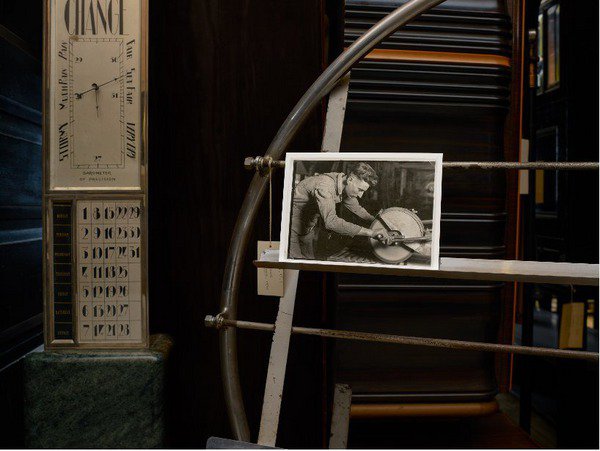Esther Shalev-Gerz
dal 2/12/2012 al 6/4/2013
Segnalato da
2/12/2012
Esther Shalev-Gerz
The Wolfsonian Florida International University, Miami Beach
"Describing Labor" draws on artist's research into depictions of work and working figures from the late 19th through the mid-20th century. The exhibition comprises large format color photographs, a two-channel HD video installation, a selection of historic artworks, and an audio installation.

Curated by Matthew Abess
The Wolfsonian–Florida International University presents Describing
Labor, an exhibition by artist Esther Shalev-Gerz, on view from December 3, 2012 through April 7, 2013.
Through new works of video, audio, and photography rooted in The Wolfsonian’s extensive collection of
materials depicting work and working figures, Describing Labor interrogates our relationship to the labor
that forges the physical world. Internationally recognized for projects that address the most pressing
challenges of collective memory, political identity, and historical space, Shalev-Gerz conceived Describing
Labor following her 2011 residency at the museum.
“Esther’s body of work is rich and provocative, asking us to explore deeply what surrounds us, both in
terms of visual culture and present-day thought,” says Marianne Lamonaca, special exhibitions curator at
the Bard Graduate Center and former associate director for curatorial affairs and education at The
Wolfsonian. “She has opened up a new dialog with our historical collection that broadens our
understanding of the role of the work of art in history and its resonance today.”
Once the heroic image of class consciousness and national character, pictured widely in the period of the
Russian Revolution, the Great Depression, and the two World Wars, the worker has since receded from
foreground of the contemporary visual landscape. “I realized that this was more or less the last time in
our recent history that images of workers conveyed a sense of heroism. Since the end of the period
represented in the collection (1885–1945), the image of the worker fell out of favor as a subject for the
arts,” says Shalev-Gerz. “It made me think about how we do not know the faces of the people who create
the things that surround us. We know other faces—politicians, celebrities, criminals—but not the worker,
the one who makes. The lines, curves, shapes, and volumes of the items in the collection give image to
the interests, passions, and quests of an epoch and those who produced it.”
For Describing Labor, Shalev-Gerz gathered forty-one objects that depict the figure of the laborer—
paintings, prints, sculptures, photographs, and rare publications—the majority drawn from The
Wolfsonian’s collection. She invited twenty-four participants to select an item and describe its depiction
while she filmed them, “letting the image talk through them,” she explains. Participants were also filmed
while listening to a voice recording of museum founder Mitchell Wolfson, Jr. reading research material
about the object. Shalev-Gerz then asked each participant to place the selected work in the museum’s
storage racks, where she photographed its representation of labor in situ with other products of labor,
such as furniture suites, decorative arts, and industrial objects from The Wolfsonian’s collection.
Describing Labor was commissioned and organized by The Wolfsonian and timed to coincide with Art
Basel Miami Beach. The exhibition includes new works by Shalev-Gerz—two long-form videos, twenty-
four large format digital photographs, audio, and text—and objects from The Wolfsonian, The Mitchell
Wolfson, Jr. Private Collection, and The Martin Z. Margulies Collection. Describing Labor is accompanied
by a catalogue featuring color images of Shalev-Gerz’s new work; essays by Jacques Rancière and
Marianne Lamonaca; and an interview with the artist conducted by Matthew Abess, The Wolfsonian’s
assistant curator.
“Esther’s work gives image to these otherwise invisible figures so that we might arrive at a new
knowledge of the human endeavor that gives shape to our daily realities,” notes Abess, who has worked
closely with Shalev-Gerz on the project. “As The Wolfsonian’s collection offers a picture of labor in its
heroic, historic moment, this exhibition re-articulates that picture for our own day and time, probing
throughout the limits of seeing and saying when faced with such an image of absence.”
Describing Labor is made possible by Gary L. Wasserman with additional support from the Adam Sender
Charitable Trust and The Arthur F. and Alice E. Adams Foundation.
About Esther Shalev-Gerz
Esther Shalev-Gerz’s work over the past twenty-five years has ranged from public monuments to
museum exhibits to video and photographic work. Based in Paris since 1984, Shalev-Gerz was born in
Lithuania, raised in Israel, and is a professor in Fine Art at the Valand Academy at Göteborg University in
Sweden. Her work has been the subject of several catalogue publications and monographs featuring texts
by eminent European and American scholars such as Jacques Rancière, Georges Didi-Huberman, and
James Young. A major retrospective of her work opened in September 2012 at Musée cantonal des
Beaux-Arts, Lausanne, Switzerland.
About The Wolfsonian–Florida International University
The Wolfsonian is a museum, library, and research center that uses objects to illustrate the persuasive
power of art and design, to explore what it means to be modern, and to tell the story of social, historical,
and technological changes that have transformed our world. The collections comprise approximately
120,000 objects from the period of 1885 to 1945—the height of the Industrial Revolution to the end of the
Second World War—in a variety of media including furniture; industrial-design objects; works in glass,
ceramics, and metal; rare books; periodicals; ephemera; works on paper; paintings; textiles; and medals.
Media contacts:
For further information, images or to arrange interviews, please contact:
Elizabeth Reina-Longoria or Deirdre Maher - Blue Medium
Tel: +1 (212) 675-1800 E: elizabeth@bluemedium.com or deirdre@bluemedium.com
Maris Bish
The Wolfsonian Tel: +1 (305) 535-2622 E: maris@thewolf.fiu.edu
The Wolfsonian is located at 1001 Washington Avenue, Miami Beach, FL.
The museum is open daily from noon-6 p.m.; Friday from noon-9 p.m.; and closed on Wednesday.
Admission is $7 for adults; $5 for seniors, students, and children age 6 -12; and free for Wolfsonian members, State University System of Florida staff and students with ID, and children under six.



